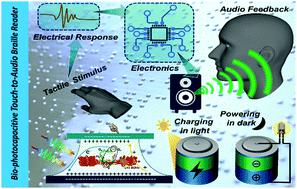当前位置:
X-MOL 学术
›
Mater. Horiz.
›
论文详情
Our official English website, www.x-mol.net, welcomes your
feedback! (Note: you will need to create a separate account there.)
Bio-photocapacitive tactile sensors as a touch-to-audio braille reader and solar capacitor
Materials Horizons ( IF 12.2 ) Pub Date : 2019-11-25 , DOI: 10.1039/c9mh01798d Sai Kishore Ravi 1, 2, 3 , Nikita Paul 1, 2, 3 , Lakshmi Suresh 1, 2, 3 , Aditya Tjitra Salim 1, 2, 3 , Tingfeng Wu 1, 2, 3 , Zixuan Wu 1, 4, 5, 6 , Michael R. Jones 7, 8, 9, 10, 11 , Swee Ching Tan 1, 2, 3
Materials Horizons ( IF 12.2 ) Pub Date : 2019-11-25 , DOI: 10.1039/c9mh01798d Sai Kishore Ravi 1, 2, 3 , Nikita Paul 1, 2, 3 , Lakshmi Suresh 1, 2, 3 , Aditya Tjitra Salim 1, 2, 3 , Tingfeng Wu 1, 2, 3 , Zixuan Wu 1, 4, 5, 6 , Michael R. Jones 7, 8, 9, 10, 11 , Swee Ching Tan 1, 2, 3
Affiliation

|
Human–machine interfaces in emerging smart-skin technologies tend to be focussed towards high-sensitivity tactile sensing primarily with visual/numerical feedback, and research on e-skin technologies for the visually impaired is sparse. Here we demonstrate a proof-of-concept six-pixel tactile sensor that converts touch stimuli based on braille codes into an auditory output, and which could potentially be miniaturized as an ‘energy-autonomous on-skin e-braille reader’ for the visually impaired. By applying the concepts of electric double layer capacitance and bio-photo capacitance, a self-powered sensor is constructed that generates electrical signals as large as 2 V by modulating a bio-electrochemical liquid bridge between electrodes of opposite wetting characteristics. The liquid bridge, composed of photosynthetic pigment–proteins with a redox electrolyte, both augments the sensory response and serves as a standalone solar-capacitor that can generate a photocurrent as high as 140 μA cm−2, and which displays a long discharge time of ∼20 min with just ∼3 min of photo charging.
中文翻译:

生物光电容式触觉传感器,用作触摸音频盲文阅读器和太阳能电容器
新兴的智能皮肤技术中的人机界面主要集中于具有视觉/数字反馈的高灵敏度触觉传感,而针对视障者的电子皮肤技术的研究也很少。在这里,我们演示了一种概念验证的六像素触觉传感器,该传感器可将基于盲文代码的触摸刺激转换为听觉输出,并且有可能被微型化为“能量自主的皮肤上电子盲文阅读器”,以在视觉上实现受损。通过应用双电层电容和生物光电电容的概念,构建了一种自供电传感器,该传感器通过调制具有相反润湿特性的电极之间的生物电化学液体电桥来产生高达2 V的电信号。液桥,-2,显示约20分钟的长放电时间,而仅带电约3分钟。
更新日期:2019-11-25
中文翻译:

生物光电容式触觉传感器,用作触摸音频盲文阅读器和太阳能电容器
新兴的智能皮肤技术中的人机界面主要集中于具有视觉/数字反馈的高灵敏度触觉传感,而针对视障者的电子皮肤技术的研究也很少。在这里,我们演示了一种概念验证的六像素触觉传感器,该传感器可将基于盲文代码的触摸刺激转换为听觉输出,并且有可能被微型化为“能量自主的皮肤上电子盲文阅读器”,以在视觉上实现受损。通过应用双电层电容和生物光电电容的概念,构建了一种自供电传感器,该传感器通过调制具有相反润湿特性的电极之间的生物电化学液体电桥来产生高达2 V的电信号。液桥,-2,显示约20分钟的长放电时间,而仅带电约3分钟。











































 京公网安备 11010802027423号
京公网安备 11010802027423号